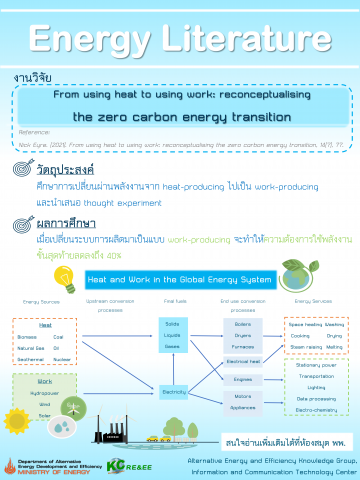From using heat to using work: reconceptualising the zero carbon energy transition
From using heat to using work: reconceptualising the zero carbon energy transition
Abstract
Recent evidence indicates that the key sources of energy for the zero carbon transition will be renewable electricity sources. The most rapidly expanding sources, photovoltaics and wind produce work, as electricity, directly rather than via heat engines. Making the assumption that these will be the dominant sources of energy in a future zero carbon system, the paper makes two new related and innovative contributions to the literature on the energy transition. First, it shows that the energy transition will be more than just a shift away from carbonaceous fuels, and that it is more usefully thought of as including a systemic shift from heat-producing to work-producing energy sources. Secondly, it shows that this enables very large improvements in the conversion efficiency of final energy, through the use of electricity and hydrogen, in particular in heating and transportation. The paper presents a thought experiment showing a reduction in final energy demand of up to 40% is likely from this effect alone. Technical standards and product regulation for end use conversion efficiency and/or service delivery efficiency seem likely to be key policy instruments.
Reference: Nick Eyre. (2021). From using heat to using work: reconceptualising the zero carbon energy transition, 14(7), 77.
บทคัดย่อ
ปัจจุบัน แหล่งผลิตไฟฟ้าจากพลังงานหมุนเวียนเป็นแหล่งพลังงานหลักในการดำเนินการตามเป้าหมายการปล่อยคาร์บอนเป็นศูนย์ แหล่งผลิตไฟฟ้าจากแสงอาทิตย์และลมเป็นแหล่งที่มีการขยายตัวได้รวดเร็วกว่าแหล่งผลิตไฟฟ้าจากเครื่องทำความร้อน ด้วยสมมติฐานที่ว่าแหล่งพลังงานเหล่านี้เป็นแหล่งพลังงานหลักในการปล่อยคาร์บอนเป็นศูนย์ในอนาคต บทความนี้จึงได้ศึกษาประเด็นเพิ่มเติมจากการทบทวนวรรณกรรมที่เกี่ยวข้องด้านการเปลี่ยนผ่านพลังงาน (energy transition) โดยประการแรก ผลการศึกษาแสดงให้เห็นว่าการเปลี่ยนผ่านพลังงานไม่ได้มีเพียงแค่การเลิกใช้เชื้อเพลิงคาร์บอนเพียงอย่างเดียว ยังมีการเปลี่ยนระบบการผลิตจากการผลิตโดยใช้ความร้อน (heat-producing) ไปเป็นการผลิตโดยใช้งาน (work-producing) ประการที่สอง work-producing ช่วยเพิ่มประสิทธิภาพในการแปลงพลังงานขั้นสุดท้ายผ่านการใช้ไฟฟ้าและไฮโดรเจนได้อย่างมาก โดยเฉพาะอย่างยิ่งในการทำความร้อนและการขนส่ง งานวิจัยนี้นำเสนอการทดลองทางความคิด (thought experiment) ซึ่งแสดงให้เห็นว่า เมื่อเปลี่ยนระบบการผลิตมาเป็นแบบ work-producing จะทำให้ความต้องการใช้พลังงานขั้นสุดท้ายลดลงถึง 40% นอกจากนี้ มาตรฐานทางเทคนิคและการกำกับดูแลผลิตภัณฑ์เกี่ยวกับประสิทธิภาพในการแปลงพลังงานขั้นสุดท้ายและ/หรือประสิทธิภาพการส่งต่อการให้บริการควรถูกใช้เป็นเครื่องมือเชิงนโยบาย

